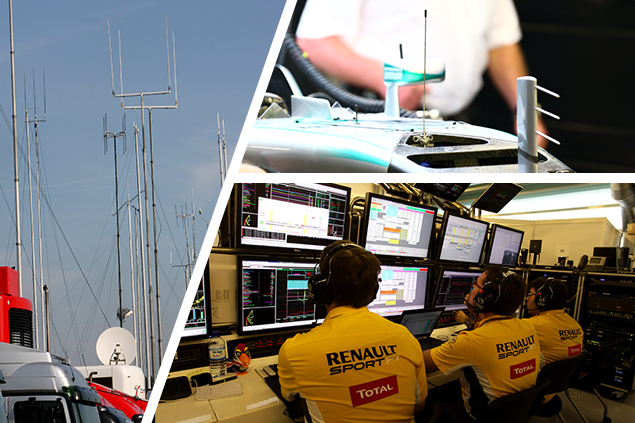Telemetry has been used in Formula One for over 30 years and grown into a vital tool to collect and analyse valuable data. But what does it actually monitor and how are the numbers crunched? F1i’s Nicolas Carpentiers brings you the answers.

©XPB Images
A Formula One car is a metal and carbon-fibre steed constantly kept under close scrutiny thanks to telemetry. Introduced in the late 1980s, this technology has been greatly developed over the years, with the FIA even permitting bi-directional telemetry in the early 2000s. However, F1’s governing body moved to limit the amount of data sent from the car back to the garage in 2003.
On each lap, an F1 machine generates 35MB of data to analyse, which means around 30GB over a grand prix weekend with two cars.
“No other form of motorsport uses telemetry as efficient as in Formula One,” said Ferrari’s electronics chief Andrea Beneventi. “For example, in GP2 there is probably 35-40% fewer parameters monitored, because the complexity of the telemetry is linked to that of the car. For example, cars competing in the Le Mans 24 Hours have a very sophisticated telemetry system.”
WHAT SORT OF INFRASTRUCTURE DOES F1 TELEMETRY REQUIRE?
Thanks to a series of sensors fitted to the car, hundreds of parameters are measured from a distance and in real time. The data are collected by a logger and sent to the teams via radio, using the antenna at the front of the car and the ones placed around the track by McLaren Applied Technologies.
“We get telemetry information in two different ways: wired, which is when the car is plugged in, and RF, which is transmitted when the car’s driving round the track,” said Simon Lock, who served as Giedo van der Garde’s electronics engineer at Caterham in 2013. “On the select 600 live channels, some are logged at kHz, some of them Hz. Some things like clutch torque, torque in the drivetrain, load cells, we record at 200Hz, so 200 times a second. If we get some heavy vibration we can put an extra log on the car and can actually log that at about 10khz if we want to do vibration analysis on various bits of the car.”
Out of caution, F1 engineers collect the data each time the car returns to the garage by uploading them onto a dedicated server, as some information may go missing. While the car sends data to the team, it can also store them: if the RF transmission gets interrupted (when the car travels through the tunnel at Monaco for instance), the system will keep re-sending the data until these have been through. Should it still fail, the team will collect the data once the car is back to the pits.
It is also worth noting that Mercedes uses high-speed Wi-Fi from semiconductor and telecommunications company Qualcomm to obtain its valuable data. Each W07 is fitted with four thermal cameras aimed at the tyres’ surface areas of contact.
That way, the team can monitor tyre wear and check how they warm up. Qualcomm’s wireless connection has replaced the recording unit where the images were stored until the team secured them once the car was stopped in the garage. Thus, Mercedes now has faster access to the footage, with the images available as soon as the Silver Arrow enters the pit lane, which allows the team to take quicker decisions.
Inside the garages, the data are then decoded and sent to the engineers’ laptops through an Ethernet network and the ATLAS (for “Advanced Telemetry Linked Acquisition System”) software package developed by McLaren Applied Technologies. All F1 teams have been using ATLAS since the FIA mandated the standard ECU, which is also supplied by McLaren.
The information is also sent to the control rooms back at the factories. The ATLAS interface is similar to an Excel spread sheet with multiple pages comprising charts and graphics that compile hundreds of parameters.

©Wri2






